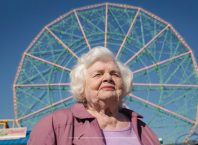“The rush of battle is a potent and often lethal addiction, for war is a drug.”
So says the opening of Kathryn Bigelow’s ‘The Hurt Locker’. The quote is taken by screenwriter Mark Boal from journalist Chris Hedges (the line is from his book ‘War Is a Force That Gives us Meaning’). It announces that this is not going to be a flowery, anti-war manifesto. It’s going to be visceral and immediate and dirty, and its politics not limited to the current war in Iraq.
The opening scene puts us straight in the thick of it, as a EOD (Explosive Ordnance Disposal) team in Iraq sends in a drone to have a look at a road-side IED (Improvised Explosive Device). Deciding to blow it up, they catch attach a wagon with explosives to the remote-controled drone and steer it to the IED. The leader of the squad, Staff Sgt. Thompson (Guy Pierce), puts on his bulky armor and walks to the bomb, while his 2 teammates, Sgt. Sanborn and Specialist Eldridge (Anthony Mackie and Brian Geraghty) watch the buildings for possible insurgents planning to harm them. We see through Thompson’s eyes, through his helmet, as he slowly and methodically walks up to the IED. He obviously knows what he’s doing, and he does not want to rush this and possibly detonate the device prematurely. A civilian takes out a cell-phone. Sanborn and Eldridge order him to drop the phone. Thompson realizes something is wrong and starts running. But before he can get far enough, the IED goes off. The interior of his helmet –through which we just looked moments ago- explodes with blood.
That is the Iraq of this film. A man takes out a cell-phone. He may be calling his wife to say he’s going to be late, he may be calling insurgents, and he may be setting off the bomb himself. People are constantly watching the soldiers from rooftops and windows. Any one of them could be an insurgent, or call one. A man waves at the soldiers, unless he’s signaling to the guys behind the soldiers. Is this guy really trying to be nice, or was he sent to distract while the sniper takes aim? With his bulky kevlar armor Thompson was like an alien invader, and he didn’t make it in the hostile environment. Ten minutes into the film and the most recognizable actor is killed off.
Thompson is replaced by SFC William James (Jeremy Renner). To the dissatisfaction of Sanborn and Eldridge, his approach is the opposite of Thompson’s. Instead of methodical, James is cavalier. He cockily marches up to the IED and rudely inspects it, almost daring it to go off. Considering that every second spent in the open gives the insurgents more time to snipe or explode the device, this approach would not be all that unreasonable. But James is focused solely on the IED, and can’t be bothered with safety protocol at all. He’ll throw a smoke grenade that makes him invisible to his teammates. He’ll take off his head-set when told he needs to evacuate the scene. This doesn’t sit well with his Sanborn, who warns James to stop his antics.
James is not a stupid man and he does care for his teammates. But he is willing to risk his own health for a showdown with a worthy adversary. Every IED is a chance for James to engage in a battle of the minds with the device’s maker. The film is episodic in its structure, going from one potentially deadly situation to the next. Its narrative lies in following James. Renner has, with Bigelow and Boal, created an amazing character in James. He is an entirely convincing and compelling character, the most fully formed character to be found in film in 2009. He feels like the quintessential male of these times, full of contradictions. He seems to constantly be fighting red-neck impulses, especially when dealing with the locals. He is naturally compassionate, but only finds definition, meaning and purpose in warfare. In that, the film seems to be in conversation with the most potent cinematic male portrait of the 90’s, ‘Fight Club’. That movie is also about men defining (or attempting to define) themselves through violence. But while that movie played it out to a problematic conclusion, ‘The Hurt Locker’ is less certain. James succeeds spectacularly at defining himself through violence. His encounters with the IED’s are mythic. He marches in there like John Wayne, out-draws and out-guns his enemy. In one of the film’s best scenes, James, upon reaching a particularly large IED, throws off his armor- “There’s enough bang in there to blow us all to Jesus. If I’m gonna die, I want to die comfortable.”
Outside of these encounters though, James has no idea how to deal with life. At night, he either literally creates a Fight Club, trading punches with Sanborn to blow off steam, or he goes hunting for bad guys to fight. He is lost outside of battle. ‘War is a Drug’ therefore seems quite accurate. Its effect, however, is to neatly sum up the film; reduce it to a catchy phrase. The film would have been better off without it. It’s so neat that it might discourage further probing into this fascinating character.
It’s one of the film’s few missteps, almost all of which occur when the film puts too fine a point on things, spells out the kind of messages that kept the audiences away from all previous Iraq films. After an emotional encounter with a disgruntled Iraqi civilian, James says “Well, if he wasn’t an insurgant before, he sure is now”. In the film’s most grisly scene, emphasis is made of the fact that the IED is comprised of U.S. military explosives. Most bluntly, James at one point angrily storms off into the Iraqis streets looking for something, with no clear idea of what it is, where it is, what it means, what he’s going to do with it. He ends up getting lost and mired in the hostile streets, running back to base, having accomplished nothing beyond harrassing some innocent Iraqis. And it is all based, of course, on faulty information. It’s an unfortunate digression that weakens the film, though not critically. Even that episode directly relates to the film’s theme of masculinity, in the impotence of James.
That impotence is countered in the film by the depictions of Men at Work. Individually, these three guys are excellent at what they do. When not fighting amongst themselves, this OED team can work together brilliantly. There are a couple of scenes of total professionalism that are thrilling, bringing to mind Hawks and Michael Mann, both of whom love people who are the best at what they do. One of these scenes, a sniper battle in the desert, is an ode to these people working as a team. It’s thrilling, tense, shows professionals working well, and gives James a chance to be the leader he has trouble being around IEDs.
This scene is one of the few sequences not in an urban setting, and gives cinematographer Barry Ackroyd a chance to let his shots breathe a bit. The film is generally shot in the shaky-cam style of The Bourne films, with very fast cutting. That style can feel opressive in some films. Here, however, spacial continuity is maintained at all times. You see everything you need to, and you always know where everything is geographically, so it is not disorienting here. The film could work well shot straight, but this allows it to feel more like a rough Samuel Fuller film- it might seem to be a bit trashy on the surface, but it is probing deeper that most of the artful, ‘tastefully’ shot films.
I’m sure there is great significance to the fact that this film was made by a woman. Bigelow has been making films about masculinity for decades now…or so I’m told. I must admit, I’ve only seen a couple of her films. Someone has said that it takes a woman to make these kinds of films, and I’m sure that might be true. I, however, do not know what to make of it. ‘The Hurt Locker’ is a terrific movie, irrelevent of whether it’s because of the director’s gender or despite it.
The film is available at The Third Ear, and will be shown on YES next month.
Image credit: http://www.flickr.com/photos/mariosundar/3659566626/
SHLOMO PORATH






Comments are closed.